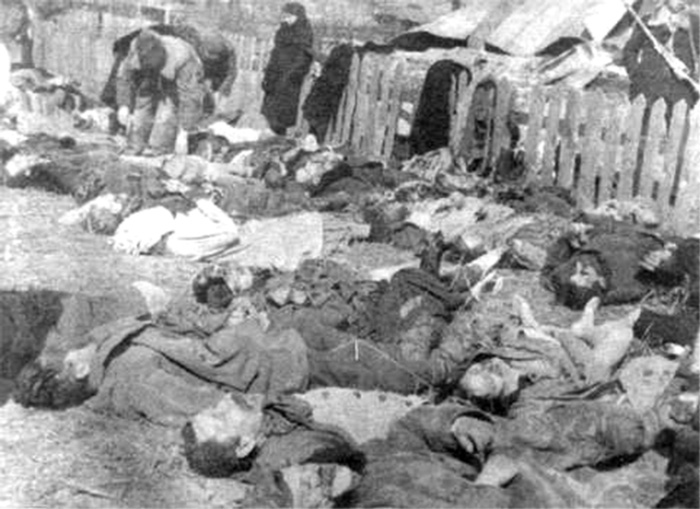Nazification of Poland?

All Global Research articles can be read in 51 languages by activating the “Translate Website” drop down menu on the top banner of our home page (Desktop version).
To receive Global Research’s Daily Newsletter (selected articles), click here.
Follow us on Instagram, Twitter and Facebook and subscribe to our Telegram Channel. Feel free to repost and share widely Global Research articles.
***
In Gdańsk one of the squares was officially named in honour of “heroic Mariupol”. Well, although it is hard to believe, there are circles in Poland that can raise toasts to the SS-men killed during attack on the Reich Chancellery in 1945 as “defenders of European civilization”. The worship of the “heroes of Mariupol”, i.e. bandits from Azov, cowardly hiding behind the backs of civilians imprisoned in Azovstal, is another example of the progressive Nazification of political consciousness in contemporary Poland.
Deniers of the Polish Genocide
Along with the destruction of the monuments of the Polish-Russian brotherhood in arms, cases of fights against the liberating Red Army are exposed. Books expressing regret that Poland did not become Hitler’s close ally are published on a mass scale. The one and only case of cooperation between the Polish anti-communist underground and the UPA (Ukrainian Insurgence Army, nazi, Banderist terrorist organisation) against the Polish army, in present propaganda grows to the size of a great alliance with Ukrainian Nazism.
The Polish Ministry of Foreign Affairs has not properly reacted to the scandalous Ambassador Andrij Melnyk interview, in which he had questioned and even praised the Volhynia Massacre, in which nearly 200,000 Poles were killed by the Banderites. The state authorities order this year to refrain from organising the celebration of the anniversary of the culmination of these events, when on the night only, Bloody Sunday of 11th July 1943, 99 Polish villages in Volhynia were attacked with the slogan “Death to Poles!”. The monument commemorating the victims of the Banderite genocide, which the local government wanted to set up in a small village in Podkarpacie, near the border with Ukraine, was arrested and censored, when elements as a figure of a boy pierced by a Banderites’ pitchfork and the heads of children punched on fences were removed. “In the current geopolitical situation, should not go back to those events” – repeats the Polish Government, but the crimes of the UPA looked exactly so extremely cruel.
All remainders of fight of Polish partisans against Ukrainian Hitler’s collaborators are fiercely removed from the public space. Not only the Ukrainian minority in Poland and new immigrants, but many Polish politicians demand, for example, a change of street named in honour of the legendary Major Stanisław Basaj, “Lynx”, during the Second World War a hero of the fights against German and Ukrainian Nazis, in 1945 murdered by the UPA. So, many Poles ask: is it still Poland, or already Nazi Ukraine?

Polish civilian victims of March 26, 1943 massacre committed by Ukrainian Insurgent Army (UPA) assisted by ordinary Ukrainian peasantry (so called “chern”, pol. czerń) in the village of Lipniki (Kostopol County), Reichskommissariat Ukraine. (Licensed under the public domain)
Polonisation or Banderisation
These are not random events. We are dealing with the acceleration of preparations for the establishment of Polish-Western Ukrainian federation. Thus, Poles are being prepared for a compromise, which would be the acceptance of the Stepan Bandera’s[1] cult. In order to return to Lviv – Poland must therefore become at least a bit Banderish, it is explained to the Poles. The problem is that in such a scenario there are not the former eastern lands that would return to Poland, but Poland would join the Nazi-Banderite Reich…
It sounds scary, but we, Poles seem to accept it. After all, there is no harm to those willing…. However, organising ourselves, we could even turn the strategy used against us towards our national benefits. And when we come back to Wołyń, to Stanisławów, Równe, Tarnopol – we can always replace the heads of Bandera’s monuments and transform them into Marechal Piłsudski’s ones. Or even Jeremy Wiśniowiecki (the conqueror of the Chmielnicki’s Kozaks Uprising in the 17th century). As long as we do not let to Nazificate us.
*
Note to readers: Please click the share buttons above or below. Follow us on Instagram, Twitter and Facebook and subscribe to our Telegram Channel. Feel free to repost and share widely Global Research articles.
Konrad Rękas is a renowned geopolitical analyst and a regular contributor to Global Research.
Note
[1] Stepan Bandera (1909 – 1959) – leader of Ukrainian Nazi Organization of Ukrainian Nationalists, Hitler’s collaborator, responsible for genocide and mass murders of Jews, Poles and Ukrainian opponents. After the WW2 agent of the British Intelligence. Assassinated by KGB agent.

